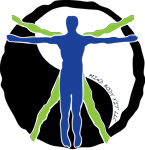The Hamstrings are an often neglected muscle group in the body. Located on the back of our thighs, they’re certainly not a “glamour” muscle group because no one sees them in the mirror. However, this muscle group is extremely vital to the strength of our legs, and the functionality of our spine. This article from strengthsensirlinc.com doesn’t focus as much on the spinal mobility and hamstring flexibility aspect, but it DOES go into great detail about great hamstring training techniques as well as common training mistakes and myths.
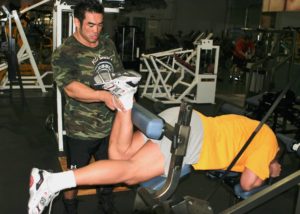 How to enhance leg development and sports performance with optimal hamstring training
How to enhance leg development and sports performance with optimal hamstring training
By Strength Sensei CP
Publication Date: 1995
The hamstrings often fall into the don’t-bother-training-what-you-can’t-see category. But the fact is, well-developed hamstrings are crucial because this muscle group makes up so much of the total leg mass – it’s apparent (or not) from all back and side angles. The visual impact of your legs will be tarnished if your hamstrings have been neglected.
Bodybuilders should strive to develop the hamstrings so that the backs of your legs make contact with each other, even when the feet are a few inches apart! The good news is that a properly-designed hamstring specialization program can, in as little as 12 weeks, dramatically enhance the appearance of your legs. What’s more, such a program can reduce the risk of injury, a must if you’re using weight training to improve performance in another sport, and can often increase your lean bodyweight by 10 pounds!
Now that you understand the importance of this often-neglected area, let’s take a closer look at what’s wrong with most hamstring workouts and review proven, practical training methods to help this important muscle group grow.
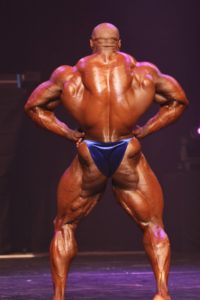 Well-developed hamstrings are impressive from all angles. (All photos by Miloš Šarčev)
Well-developed hamstrings are impressive from all angles. (All photos by Miloš Šarčev)
Functional Training of the Hamstrings
The hamstrings consist of three muscles: the biceps femoris, better known in gyms as the leg biceps; the semitendinosus; and the semimembranosus. Understanding the functions of each of these muscles is the first step toward devising effective hamstring workouts. Here are some details:
Biceps Femoris.The biceps femoris enhances the outer (posterior) sweep of the hamstrings. Like its cousin, the biceps brachii, the biceps femoris consists of two heads, the long head and the short head. The long head crosses both the hip and knee joint, and is therefore involved in extending the hip and flexing the knee; the short head only crosses the knee joint and thus is only involved in flexing the knee. However, both heads help turn the foot outward (lateral rotation of the knee).
Semitendinosus and Semimembranosus:These muscles, collectively referred to as the medial hamstrings, enhance the inner sweep of the hamstrings. They cross the hip and knee joint and are therefore involved in extending the hip and flexing the knee. They also help turn the knee inward (medial rotation).
Muscles that assist the hamstrings.The muscles that help the hamstrings flex the knee are the sartorius, gracilis, and gastrocnemius. The muscles that help the hamstrings extend the hip are the glutes and erector spinae.
 The biceps femoris enhances the outer sweep of the hamstrings and is especially pronounced in these women bodybuilders.
The biceps femoris enhances the outer sweep of the hamstrings and is especially pronounced in these women bodybuilders.
4 Myths about Hamstring Training
Before getting into my tips about what works in hamstring training, let’s discuss four common myths associated with this muscle group.
Myth #1. Bodybuilders have the best hamstring development of all athletes. Without question, the athletes who possess the best hamstring development are sprinters – just look at the leg development of these athletes the next time there’s a track competition on TV. IFBB Mr. Universe Robby Robinson has some of the best hamstrings in the bodybuilding world. Tt comes as no surprise that in his youth, he did lots of sprinting.
Sprinters have great hamstrings because these muscles extend the hip during running. Sprinting also requires extreme force production, and as such the fast-twitch fibers of the hamstrings must contract with maximum intensity to propel the body forward. Bobsledders also have excellent hamstring development because they sprint for short distances while pushing a sled that can weigh over 600 pounds! Ian Danney, a bobsledder I coach who has front squatted 418 pounds for two reps at a bodyweight of only 180 pounds, possesses hamstring development equal to that of any bodybuilder’s.
Myth #2. The leg curl is the best exercise for the hamstrings. For knee joint integrity, most physical therapists recommend a 66 percent hams-to-quad strength ratio, which means the hamstrings produce 66 percent of the force of the quadriceps. When some of the Canadian skiers I tested performed only half squats, their average ham/quad ratio was 58 percent. After 11 weeks of deep squats, the ratio improved to 79 percent. (Incredibility, our best sprinters will have a ratio 125 percent, almost twice what physical therapists recommend.)
A simple way to determine your ham/quad ratio is to test your maximal front squat, which ideally should be 85 percent of your back squat. If you want your ham/quad ratio assessed in a laboratory, make sure the researchers use a Kin-Com machine. The Kin-Com machine is the best available because it also measures eccentric strength.
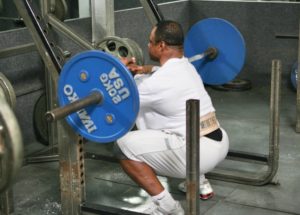 Optimal hamstring/quad ratio can be determined by testing the back and front squat. Your front squat maximum should be 85 percent of your back squat.
Optimal hamstring/quad ratio can be determined by testing the back and front squat. Your front squat maximum should be 85 percent of your back squat.
Myth #3. A cam provides the best resistance curve for the hamstrings. During knee flexion, the hamstrings express a force curve in a descendingshape; that is, the muscles produce less force at the end of the movement. However, a shell-shaped cam (such as used on many Nautilus machines) provides increasing resistance during a movement. As they say in Australia. “What does this have to do with the price of fish?” By overloading the weak points of the movement and underloading the strong points, you disturb the force production of the hamstrings and therefore increase the risk of injury. The hydraulic leg curl machines I’ve seen have an even worse pattern overload for the knee flexors.
Besides having the wrong force curve, many cam leg curl machines I’ve seen have a flat surface that can aggravate or even cause a low-back injury, especially if the individual using it stores a lot of fat on the abdominal wall. This machine should have been designed with a “hump” shape to position the hamstrings in a better pre-stretch position.
Myth #4. The hamstrings should be trained with high reps. Focusing on high reps is probably one of the biggest reasons why most bodybuilders don’t have impressive hamstrings.
Earlier I praised the hamstring development of sprinters — how far do sprinters run? Generally, about 200 meters or less. How long does it take? About 21 seconds. Although the time under tension is short, these athletes possess enormous hamstring development because these muscles are primarily composed of fast-twitch fibers that respond better to heavy weights and low reps.
Numerous studies on the relationship between maximal strength tests and the number of repetitions performed (at a given maximum) have shown repeatedly that the hamstrings are not designed for reps. Although you may be able to perform 10-12 reps at 70 percent of your maximum on the bench press, you may only complete only 7-8 reps with the same percentage on the leg curl. If you use 15-20 reps per set on hamstring exercises, your training intensity would be approximately 50-55 percent of your maximum. Such a low-intensity level would not provide enough tension for these fast-twitch muscles to grow.
8 Tips for Getting the Most from your Hamstring Workouts
Now that we’ve explored a few myths about hamstring training, let’s examine training methods that will help you achieve optimal hamstring development.
Tip 1. Select exercises that train all functions of the hamstrings.Magnetic Resonance Imaging (MRI) technology has demonstrated that leg curls do only part of the job in hamstring recruitment. For example, the supine (lying) leg curl involves the biceps femoris, semitendinosus, sartorius, and gracilis. The semi-stiff-legged deadlift and good mornings involve the adductor magnus, adductor brevis, biceps femoris, and semitendinosus. Therefore, your hamstring workouts should contain exercises for both the hip extension function (good mornings, reverse hypers, and semi-stiff-legged deadlifts) and the knee flexor function (seated and prone leg curls). That said, there are some limitations of MRIs.
By measuring the amount of heat produced in each area being worked, scientists are able to determine with MRIs the most effective exercises for a body part. These results were published in the book Muscle Meets Magnetby Per A. Tesch. Recently, many trainers and coaches have been using the results of this research when designing their athletes’ routines. Even though this book is a valuable purchase, the theories it puts forth have several limitations. Here are three of them:
a) Intensity selection.During testing, researchers used 70 percent of a 1RM (repetition maximum) for 5 sets of 10-12 reps. There is a need to investigate if the recruitment patterns are affected by training intensity. In other words, would other muscle fibers be called into play if the intensity were, let’s say, 85 percent of the 1RM?
b) Number of subjects.The authors used only five subjects. If you have any sort of training in statistical analysis, you know at least 30 subjects are needed to draw a credible conclusion.
c) Experience of subjects.The recruitment patterns noted from the data could have been influenced by the training experience of the subjects.
Muscle Meets Magnet is the first attempt at collecting data on bodybuilding exercises using MRI technology, and it’s a respectable one. However, don’t consider it the gospel in this field – at least, not until further research is completed.
 Reverse hypers emphasize the hip extension function of the hamstrings.
Reverse hypers emphasize the hip extension function of the hamstrings.
Tip 2. Train one leg at a time.From testing on the Kin-Com unit, we found many top-level athletes had strength disparities between their two legs. It appears that the dominant leg of some athletes will often be as much as 20 percent stronger than the non-dominant leg—these athletes definitely need single-limb training to prevent injuries. Incidentally, the dominant leg is not necessarily on the same side as the dominant hand; in other words, it isn’t because you’re right-handed that your right leg is dominant in the lower body. Also, because of a neurological effect called the bilateral deficit, the hamstrings will contract harder if they’re trained one leg at a time.
Tip 3. Stretch the hamstrings both at the hip and knee joints to facilitate recruitment.This means the knees must be extended and the hips flexed in the starting position. Thus, during the standing leg curl, you would need to bend forward from the waist and start with the legs straight before beginning the movement.
Tip 4. Stretch the quadriceps between sets of hamstring work.Increasing the range of motion of your hamstrings will increase the amount of muscle mass used during the exercise and therefore increase its effectiveness. Stretching the quadriceps, which are the antagonist of the hamstrings, increases your range of motion because it reduces muscle tension that can shorten the hamstrings.
Tip 5. Use eccentric training.Eccentric (negative) training refers to the lowering portion of an exercise, as opposed to concentric (positive) training, which refers to the lifting portion. The hamstrings respond well to eccentric work. Triple jumpers and long jumpers are known for their hamstring development. Besides the sprinting they do in their events, they have to absorb high-impact landings, which prompt high levels of eccentric contractions from the hamstrings.
Tip 6. Emphasize low reps and multiple sets.Because of the high fast-twitch composition of the hamstrings, there’s little point in training with high repetitions. When you use more than 8 reps during hamstring exercises, you’re training below 70 percent of your 1RM. This intensity level that will not increase sufficient tension to elicit hypertrophy and a strength response.
Tip 7. Strive for balance between the medial and lateral heads of the hamstrings.The body never lies. To test if there’s a head of the hamstrings that needs remedial specialization, select a weight you can do for 6RM in the leg curl with your feet in the neutral (straight) position. As you reach muscular failure, your feet will rotate in one direction if there is a lack of balance between the two heads of the hamstrings. If they turn towards the mid-line of the body (medial rotation), your semitendinosus and your semimembranosus are too strong for your biceps femoris. If they turn away from the midline of the body (lateral rotation), your biceps femoris is too strong for your semitendinosus and semimembranosus.
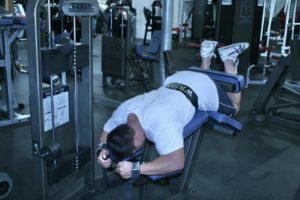 Turning your toes outward or inward during a leg curl influences how hard each hamstring muscle is worked.
Turning your toes outward or inward during a leg curl influences how hard each hamstring muscle is worked.
Tip 8. If you have balanced hamstring development, vary your position frequently.Because each exercise offers a unique pattern overload, variety is an essential requirement for maximal hamstring development. You probably have more hamstring exercises at your disposal than you think. Let’s say your gym has the four major types of leg-curl units: seated, lying, standing, and bent-over kneeling. This will give you an arsenal of 12 hamstring curl exercises: 4 machines x 3 foot positions (neutral, inward, outward) = 12 permutations.
Using a variety of hamstring exercises is essential for maximum development. Shown is the seated version of the leg curl.
Consider that optimal hamstring development requires more than just a few sets of leg curls at the end of your workout. To take your training to the next level of development, make hamstring training a priority, and work them as hard as you would your arms or chest.
One of the rewarding aspects of hamstring training is that the results become quite visible – this is a monster of a muscle group and, when developed, it’s gratifying to show off. Remember these 4 hamstring myths and use my 8 training tips, and you’ll immediately begin to feel and see the results!
